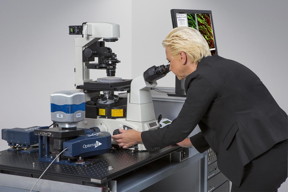Home > Press > Bruker Introduces Opterra II Multipoint Scanning Confocal Microscope: High-Speed Confocal System Provides Most Quantitative and Flexible Live-Cell Imaging
 |
Abstract:
Bruker today announced the release of the Opterra II™ Multipoint Scanning Confocal Microscope, which represents the next generation of quantitative live-cell microscopes. The Opterra II’s low photo-toxicity and photo-bleaching capabilities deliver significant advantages over today’s spinning disk confocal approaches, including enabling time-lapsed volumetric studies on previously inaccessible specimens. This performance is achieved through the system’s unique ability to optimize an experiment’s imaging conditions through real-time adjustment of imaging speed, resolution, and sensitivity. Additionally, the Opterra II provides sub-10% field uniformity deviation, allowing quantitative analysis, in all dimensions, as a standard feature.
Bruker Introduces Opterra II Multipoint Scanning Confocal Microscope: High-Speed Confocal System Provides Most Quantitative and Flexible Live-Cell Imaging
Billerica, MA | Posted on August 10th, 2015“In a matter of a few hours after setup of the system we were collecting publication-quality data with Opterra II,” said Dr. William Bement, Chair of Laboratory Cell and Molecular Biology at the University of Wisconsin, in Madison, WI. “The speed of the system, coupled with its photo-activation capabilities allowed us to collect data, and see interactions, that we had theorized about but had not seen until now. Opterra II has allowed us to overcome obstacles that have impeded our research for the past 5 years.”
“Making quantitative optical performance ‘standard,’ while enhancing the microscope’s ease and flexibility of operation, all while expanding the applications space into longer term live-cell studies, were our key design challenges for the Opterra II,” explained Stephen C. Minne, Ph.D., General Manager of Bruker's Fluorescence Microscopy business. “Early customer feedback on the system’s performance, as well as the versatility of its new high-speed filter wheel and bypass module, is that the Opterra II is leap-frogging currently available technology.”
About Opterra II
Opterra II is based on Bruker’s patented multipoint confocal microscopy technology and swept-field scanner. The new system provides next-generation functionality compared to spinning disk systems through its ability to tailor speed, resolution, and intensity to provide low photo-toxicity and photo-bleaching on any biological specimen. The Opterra II also features a sub-10% field illumination uniformity; options for bypass capability for wide-field, bright-field, and TIRF imaging; a high-speed 10-position filter wheel; as well as photo-activation, spectral imaging and un-mixing capabilities.
####
About Bruker Corporation
For more than 50 years, Bruker has enabled scientists to make breakthrough discoveries and develop new applications that improve the quality of human life. Bruker’s high-performance scientific research instruments and high-value analytical solutions enable scientists to explore life and materials at molecular, cellular and microscopic levels.
In close cooperation with our customers, Bruker is enabling innovation, productivity and customer success in life science molecular research, in applied and pharma applications, in microscopy, nano-analysis and industrial applications, as well as in cell biology, preclinical imaging, clinical research, microbiology and molecular diagnostics.
For more information, please click here
Contacts:
Stephen Hopkins
Marketing Communications
Bruker Nano Surfaces Division
T: +1 (520) 741-1044 x1022
Copyright © Bruker Corporation
If you have a comment, please Contact us.Issuers of news releases, not 7th Wave, Inc. or Nanotechnology Now, are solely responsible for the accuracy of the content.
| Related News Press |
News and information
![]() Researchers develop molecular qubits that communicate at telecom frequencies October 3rd, 2025
Researchers develop molecular qubits that communicate at telecom frequencies October 3rd, 2025
![]() Next-generation quantum communication October 3rd, 2025
Next-generation quantum communication October 3rd, 2025
![]() "Nanoreactor" cage uses visible light for catalytic and ultra-selective cross-cycloadditions October 3rd, 2025
"Nanoreactor" cage uses visible light for catalytic and ultra-selective cross-cycloadditions October 3rd, 2025
Imaging
![]() ICFO researchers overcome long-standing bottleneck in single photon detection with twisted 2D materials August 8th, 2025
ICFO researchers overcome long-standing bottleneck in single photon detection with twisted 2D materials August 8th, 2025
![]() Simple algorithm paired with standard imaging tool could predict failure in lithium metal batteries August 8th, 2025
Simple algorithm paired with standard imaging tool could predict failure in lithium metal batteries August 8th, 2025
![]() First real-time observation of two-dimensional melting process: Researchers at Mainz University unveil new insights into magnetic vortex structures August 8th, 2025
First real-time observation of two-dimensional melting process: Researchers at Mainz University unveil new insights into magnetic vortex structures August 8th, 2025
![]() New imaging approach transforms study of bacterial biofilms August 8th, 2025
New imaging approach transforms study of bacterial biofilms August 8th, 2025
Announcements
![]() Rice membrane extracts lithium from brines with greater speed, less waste October 3rd, 2025
Rice membrane extracts lithium from brines with greater speed, less waste October 3rd, 2025
![]() Researchers develop molecular qubits that communicate at telecom frequencies October 3rd, 2025
Researchers develop molecular qubits that communicate at telecom frequencies October 3rd, 2025
![]() Next-generation quantum communication October 3rd, 2025
Next-generation quantum communication October 3rd, 2025
![]() "Nanoreactor" cage uses visible light for catalytic and ultra-selective cross-cycloadditions October 3rd, 2025
"Nanoreactor" cage uses visible light for catalytic and ultra-selective cross-cycloadditions October 3rd, 2025
Tools
![]() Japan launches fully domestically produced quantum computer: Expo visitors to experience quantum computing firsthand August 8th, 2025
Japan launches fully domestically produced quantum computer: Expo visitors to experience quantum computing firsthand August 8th, 2025
![]() Rice researchers harness gravity to create low-cost device for rapid cell analysis February 28th, 2025
Rice researchers harness gravity to create low-cost device for rapid cell analysis February 28th, 2025
|
|
||
|
|
||
| The latest news from around the world, FREE | ||
|
|
||
|
|
||
| Premium Products | ||
|
|
||
|
Only the news you want to read!
Learn More |
||
|
|
||
|
Full-service, expert consulting
Learn More |
||
|
|
||








